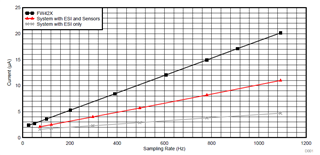Other Parts Discussed in Thread: EVM430-FR6989, ENERGYTRACE, UNIFLASH
Dear Ti team,
I'm having a problem with the sampling rate, and power consumption on ESI according to this:

I've changed the sampling rate with the values: 6, 10, 25, 50 and 100 Hz and the consuption didn't change. Using FLOW ESI GUI I could find the parameter to change:
// Set sampling frequency to User selected sampling frequency
gTSMSettings = ESI_TSM_INITPARAMS_DEFAULT;
gTSMSettings.startTriggerSelection = ESI_TSM_START_TRIGGER_ACLK_OR_SOFTWARE;
gTSMSettings.startTriggerAclkDivider = ESI_TSM_START_TRIGGER_DIV_450; // 450 -> 6Hz 390->10Hz 162 -> 25Hz 78-> 50Hz 30-->100Hz
ESI_TSM_init(&gTSMSettings);
Can someone help me? Is there any reason or a recommendation? Power consumption is around 6.5uA
Best regards
Samuel

